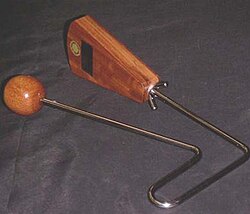Vibraslap
 A vibraslap manufactured by Latin Percussion |


The vibraslap is a percussion instrument consisting of a piece of stiff wire (bent into a U-shape) connecting a wood ball to a hollow box of wood with metal “teeth” inside. The percussionist holds the metal wire in one hand and strikes the ball (usually against the palm of their other hand). The box acts as a resonating body for a metal mechanism placed inside with a number of loosely fastened pins or rivets that vibrate and rattle against the box.[1] The instrument is a modern version of the jawbone.[2]
Invention
The vibraslap was the first patent granted to the instrument manufacturing company Latin Percussion.[3]
The vibraslap's inventor was Martin Cohen.[4] Cohen was told by percussionist Bobby Rosengarden, "If you want to make some money, make a jawbone that doesn’t break." About the inventing process Cohen remembers, "I had never seen a jawbone before, but I had heard one on a Cal Tjader album. I found out that it was an animal skull that you would strike, and the sound would come from the teeth rattling in the loose sockets. So I took that concept and invented the Vibraslap, which was my first patent." [5]
Origins
The vibraslap descended from the African "jawbone". This is the lower jawbone of a donkey or a zebra which has loose teeth that rattle when the instrument is struck.[6] The Instrument was carried by slaves to South America where it became known as the Quijada.[7]
Differing names
The vibraslap comes in a variety of sizes and materials and is sometimes marketed under the name "Donkey Call", "Vibraphone", "Bloodsnake", "Donkey Rattle" or "Rattleslap."
Examples in well-known music
The Vibraslap can be heard very clearly on the 1967 US No. 1 hit single "Green Tambourine" by The Lemon Pipers. It can be heard on a number of famous rock songs like "Crazy Train" by Ozzy Osbourne, "Sweet Emotion" by Aerosmith, and "Feelin' Alright" by Joe Cocker. Also notable: Brian Jones of The Rolling Stones played the vibraslap in the Jimi Hendrix song "All Along the Watchtower".[8] The Vibraslap is also used in the songs "Billionaire" by Travie McCoy and "I Don't Like It, I love It" by Flo Rida. It can also be heard in "Asesina" by Okills.
References
- ^ "Vibra-Slap", Music.VT.edu. URL last accessed December 11, 2009.
- ^ "Donkey Call or Vibraslap". Ethnic Musical Instruments.com. Retrieved April 26, 2015.
- ^ "LP Vibra-Slap II - Standard Wood (LP208)", SteveWeissMusic.com. URL last accessed December 11, 2009.
- ^ "USPTO",USPTO.
- ^ "PASIC 2012", PAS.org. URL last accessed December 11, 2009.
- ^ Karl Peinkofer and Fritz Tannigel, Handbook of Percussion Instruments, (Mainz, Germany: Schott, 1976), 159.
- ^ Afro Peruvian Percussion & the Cajon: Basic History & Rhythms Accessed online February 24, 2015
- ^ Padgett, Ray: The Story Behind Jimi Hendrix's "All Along the Watchtower."

